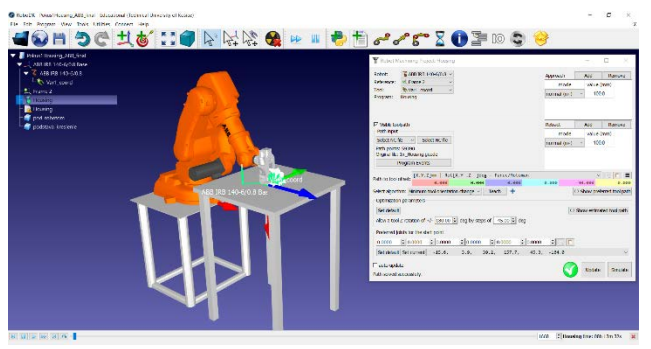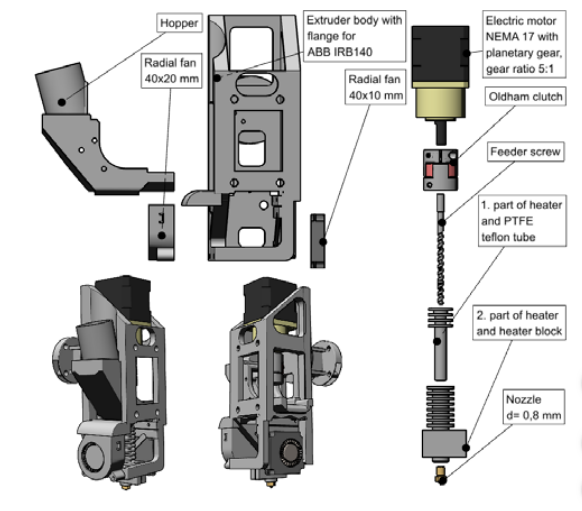In ‘Design of the 3D Printhead with Extruder for the Implementation of 3D Printing from Plastic and Recycling by Industrial Robot,’ authors Martin Pollák, Jakub Kaščak, Monika Telišková, and Jozef Tkáč from Technical University of Košice, Faculty of Manufacturing Technologies, are exploring numerous levels of 3D printing and integrated electronics, but mainly delving into the use of a printhead able to extrude multiple material types.
 Ultimately, the mission of the authors was to combine 3D printing with robotics in order to make the printhead, and then be able to fabricate large objects not constrained by smaller working spaces. Pointing out that ‘under the term additive manufacturing 3D printers are mainly hiding,’ the authors explain the impacts such technology has had on the world and ‘in many areas of human activity.’
Ultimately, the mission of the authors was to combine 3D printing with robotics in order to make the printhead, and then be able to fabricate large objects not constrained by smaller working spaces. Pointing out that ‘under the term additive manufacturing 3D printers are mainly hiding,’ the authors explain the impacts such technology has had on the world and ‘in many areas of human activity.’
Research and development divisions–especially at colleges and research labs–rely on 3D printing; however, the integration of robotics is still evolving. In this study, the authors proposed to create a printhead able to use not just the typical filament and granulate, but also recycled PET bottle materials.
The nozzle is the primary component of the printhead:
“The nozzle has to have good thermal properties and ensure perfect overheating of the melting chamber. For this reason, brass, aluminum or copper are most commonly used for their production. During the contact of melt and plastic material with copper, its catalytic decomposition can occur and therefore further treatment is required,” the researchers explained.
“The proposed printhead opens up new possibilities for additive technologies. It allows us to print alternate forms and different types of materials, mix them, add additives, or change their color.”
The following elements are required:
- Recyclates with 30-300 °C melting point
- Filament and granulate diameter of 0.5 to 5mm
- Nozzles with diameter of 0.2 to 3mm
- Large-scale production potential
- Flexibility in modification after testing
The research team also centers around the use of robots today—accompanying 3D printing and additive techniques—as the ‘most flexible element of the entire industry.’ Pointing out the many obvious uses for robotics within automotive, the researchers explain that advanced electronics also play a role in many applications such as architecture and construction. The part they play in recycling can be substantial as well as they are able to perform a variety of actions.

Software simulation plays an important role also—particularly for automation processes integrating robotics. The researchers use RoboDK, available as an ‘offline programming solution,’ as well as offering the potential for creating robot-specific language. Motion can be created via simulation or through Python code. The simulation program is ‘highly versatile’ and currently supports over 200 industrial robotic systems.
“To create a 3D print simulation design, it is important to realize that not only is the virtual robotized design itself implemented, but the final product of the simulation design is to generate a real robot program that will print the selected 3D object using the extruder 3D printhead prototype,” state the authors.

Implementation of simulation and program generation design for 3D printing needs by selected industrial robots in the software RoboDK.
While there is an ongoing emphasis on robotics in their research, the authors realize that while most are already aware of the significant impacts 3D printing is going to have around the world, there are still expansive research and development opportunities available regarding hardware, software, and materials. Much of the continued design efforts will center around 3D printing avenues such as printhead design and material usage. In this study, specific customizations were required for integrating robotics.
“In the design, it was necessary to pay attention to the dimensions and maximum weight of the head made, with regard to its attachment to the robotic arm flange. For this reason, in addition to the design of the printhead itself, it has also been proposed to design the extruder design as a means of transforming the feed material into the melt, which will be applied to the work surface via a suitably selected nozzle (the size of the nozzle will depend on the type of material to provide 3D printing) afterword,” concluded the researchers.
“The main movement of 3D object printing will be ensured by a robotic arm based on the program, which is created by a suitable software solution. The result of the project will be the implementation of 3D printing by designed 3D printing system for the printing of oversized components using various recycled materials and their application, with the proposed print head. The proposed concept will allow dispensing and printing various types of plastic and other materials, compositing, and further development in the field of additive technologies as well.”
Robotics continues to play an integral part within so many innovations, as new materials are created for programmable robotics, 3D printing allows for ongoing customizations, and industries like aerospace see numerous opportunities opening up due to the integration of 3D printing and electronics.
What do you think of this news? Let us know your thoughts! Join the discussion of this and other 3D printing topics at 3DPrintBoard.com.
[Source / Images: ‘Design of the 3D Printhead with Extruder for the Implementation of 3D Printing from Plastic and Recycling by Industrial Robot’]
Subscribe to Our Email Newsletter
Stay up-to-date on all the latest news from the 3D printing industry and receive information and offers from third party vendors.
You May Also Like
Gorilla Sports GE’s First 3D Printed Titanium Cast
How do you help a gorilla with a broken arm? Sounds like the start of a bad joke a zookeeper might tell, but it’s an actual dilemma recently faced by...
Nylon 3D Printed Parts Made More Functional with Coatings & Colors
Parts 3D printed from polyamide (PA, Nylon) 12 using powder bed fusion (PBF) are a mainstay in the additive manufacturing (AM) industry. While post-finishing processes have improved the porosity of...
$25M to Back Sintavia’s Largest Expansion of Metal 3D Printing Capacity Since 2019
Sintavia, the digital manufacturing company specializing in mission-critical parts for strategic sectors, announced a $25 million investment to increase its production capacity, the largest expansion to its operations since 2019....
Velo3D Initiates Public Offering in a Bid to Strengthen Financial Foundations and Drive Future Growth
Velo3D (NYSE: VLD) has been among a number of publicly traded 3D printing firms that have attempted to weather the current macroeconomic climate. After posting a challenging financial report for 2023,...































